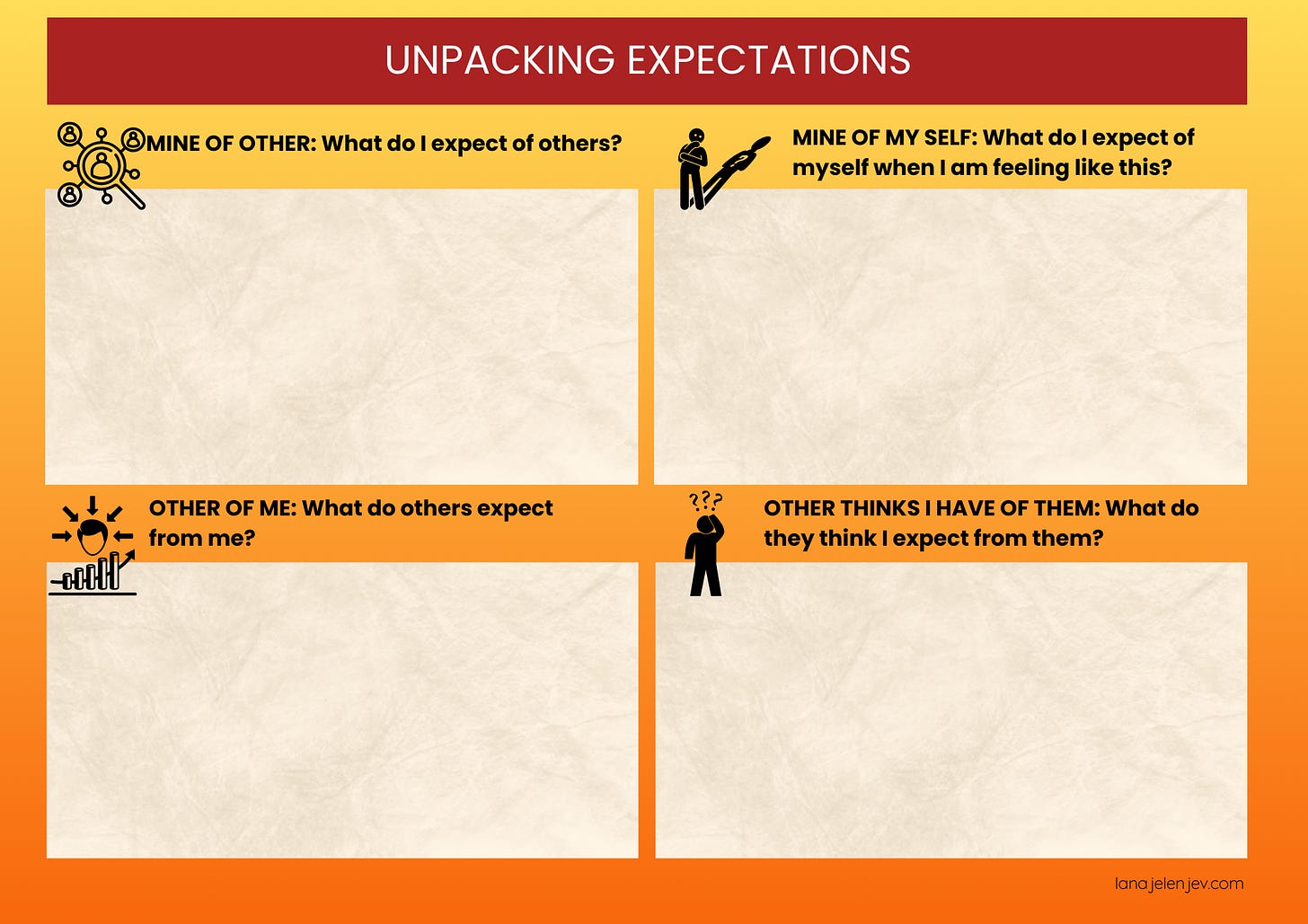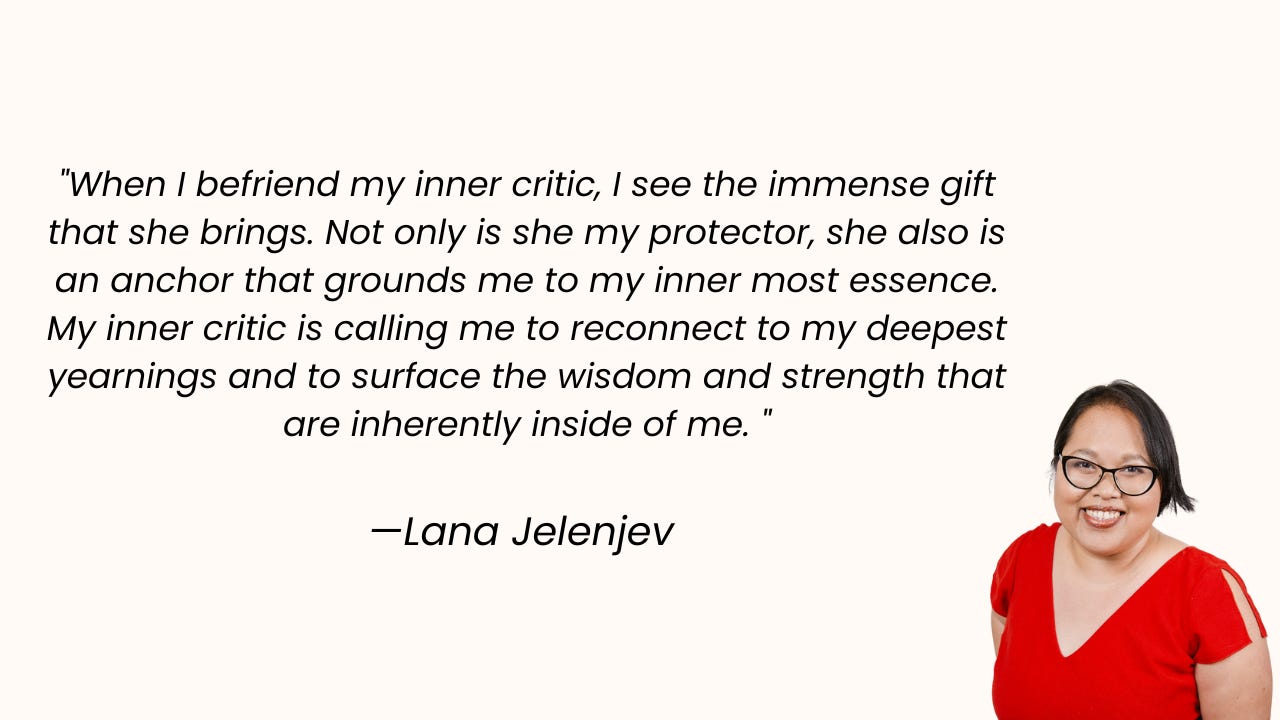GIVING OURSELVES GRACE BY BEFRIENDING OUR INNER CRITIC (Part 4)
This is a 4-part article exploring the Inner Critic through Satir's Personal Iceberg Model
Read the different parts of this series:
Part 1 on Importance of our inner critic and our coping stances
Part 2 on Feelings, Pseudo Feelings, and Feeling about our Feelings
Part 3 on Perceptions
This is the last part about Satir’s Personal Iceberg Model where we explore Expectations, Yearnings and the Self.
UNPACKING EXPECTATIONS
Expectations come from our past experiences, but also from family, friends, media, legends, stories, religion, myth, culture, race, gender, rank in society, etc.
Unmet expectations affect one's self-esteem, wellbeing, and ability to connect with others. It is important to surface expectations based from:
Mine of other: What do I expect of others?
Mine of my Self: What do I expect of myself when I am feeling like this?
Other of me: What do others expect from me?
Other thinks I have of them: What do they think I expect from them?
Along with learning about our expectations, it is important for us to support individuals in "letting go" of their unmet expectations. We also need to understand how our behaviors interact with our expectations.
UNDERSTANDING OUR YEARNINGS
The iceberg is Satir’s main metaphor for showing the various layers that make up a human. In this metaphor, a person is seen as a multi-dimensional system. A system is defined as a set of actions, reactions, and interactions between a set of basic variables that develop an order and sequence to produce a result. In other words, a system is a set of interacting dimensions and variables that yields more than the sum of its parts; change to a part or dimension is associated with change in other dimensions. Behavior and communication represent only the tip of the iceberg’s whole of the multi-layered personality. Satir’s iceberg consists of three dimensions: interpersonal (Behaviors, Coping Stances), intrapsychic (Feelings, Feelings About Feelings, Perceptions, and Expectations), and universal spirituality (yearnings and Self: I am). Being a system, these dimensions are linked in that a change in one element relates to changes in other elements. Congruence is the harmonious interaction of these important dimensions within a person (Satir et al., 1991).
Satir identifies “yearnings” as universal among human beings, and hence cannot be denied or disregarded. Being congruent at the level of yearnings means to acknowledge one’s humanity and what one longs for and strives to actualize it.
It is important to uncover the yearnings that underlie behaviors, coping stances and feelings as well as acknowldge both fulfilled and unfulfilled yearnings. Yearnings when fulfilled can fuel us to have hope and energy. When unfulfilled, it contributes to expectations of the self, of others, and from others.
Yearnings include the longing to love oneself, to love others, to be loved by others, to be accepted, validated, confirmed, and our search for purpose and meaning.
" The yearnings to love oneself, to love others, and to be loved by others are universal.”
-Virginia Satir
Here are some questions to explore your yearnings:
What deeper longings need tending, expression and fulfilment right now?
What do I need to respond congruently right now?
What hopes am I cherishing? And why are these relevant?
RECONNECTING TO THE SELF:I AM
The Self: I am refers to the “life force, spirit, soul, core, essence”. This is who we are, have been, and always will be; the very core of who we are. All people are innately good and have positive Life Energy at their core.
“As I have been evolving, I have had experiences that tell me that there exists something that could be called the life-force or universal mind. I know that there are many dimensions in this force that are powerful formers of human behavior. It seems to me a little like the presence of electricity. It was always there, yet it waited for someone to identify it, then learn ways to use it for beneficial purposes. This probably could be referred to as psychic power, something all of us have experienced as atmosphere. There are already some ideas that each body is like an individual electrical generating unit. Our energy creator, and the amount and use of its own electrical power, is controlled mainly by belief and feelings of self-worth. I know that when I am in a state of low self-esteem my energy is low and frequently misdirected - mostly against myself. For me, these experiences provide a very fruitful direction in which to go .”
-Virginia Satir
Self is always changing and entirely malleable. This is where spiritual connection exists coming from a wellspring of life energy, presence and deep soul essence.
Tapping into yearnings provides a natural and organic way to connect with the deeper spiritual meaning in our lives and with the life energy that emanates from those yearnings. Our goal is to release the blocks that keep the Life Force from flowing freely, especially given its innate healing capacity. Transformation is described as the journey to find this connection again. In Satir’s model, harmony is a spiritual process of re-humanization by reconnecting with others, one’s own roots and others’, and the spiritual essence of nature.
“We have the ability to change, expand, and manifest growth.”
-Virginia Satir
CONGRUENCE IS THE KEY
A strong belief by Virginia Satir is that change is always possible, even if change can only take place inside of the person. These changes might include feelings, perceptions, and expectations. Satir’s goal was to guide people in reaching their full potential. She believed that how people view themselves and their self-worth, are the underlying roots of their problems.
Satir described three levels of congruence:
(1)The first level is under the waterline to become aware of and familiar with one's feelings, expectations, perceptions and yearnings.
(2) The second level is awareness, acceptance, experience, and the knowledge of self-wholeness.
(3) The third level is of spirituality and universality.
Reflect on these questions:
When am I in harmony and flow?
What blocks harmony and flow?
When, where, and with whom do I feel and act with congruence?
How do I behave and feel when I am incongruent?
So this is the final part in Satir’s iceberg model. I do hope this has served you in your journey of listening to your inner critic with a different framing. Knowing about this model has been serving me in reconnecting to my yearnings and leading me gently back to myself. May this be your experience as well.
Hiraya manawari,
Lana






